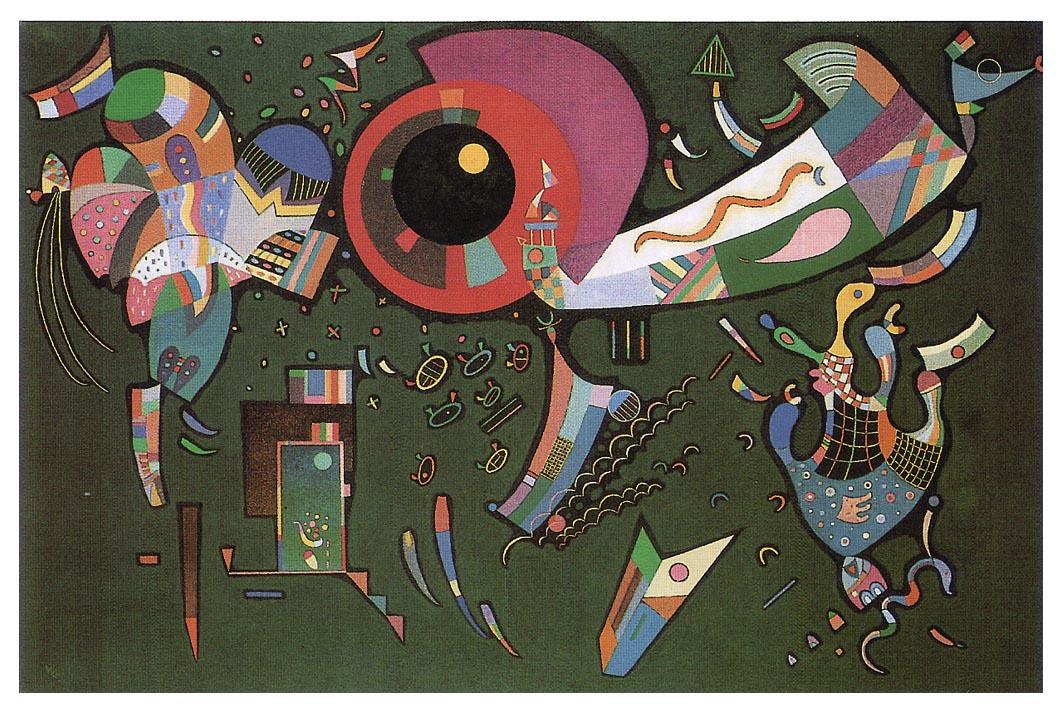Description
Also known as "Around the Circle." ( autour du cercle )
Kandinsky's use of biomorphic forms attests to his fascination with the organic sciences, particularly embryology, zoology, and botany. During his years at the Bauhaus, Kandinsky had cut out and saved illustrations of microscopic organisms, insects, and embryos. He also owned several important scientific books and encyclopedias, from which he derived abstract depictions of tiny creatures, as exemplified in Around the Circle , May–Aug 1940.
Wassily Kandinsky He is recognized as an important artistic and theoretical innovator of painting. In the early decades of the 20th century, he was among those who promoted nonrepresentational modes of artistic creation to lasting effect. The artist's stylistic evolution in this sense was intimately linked to his sense of place and the communities with which he interacted. Kandinsky drew insights from significant intersections with artists, musicians, poets, and other cultural producers, especially those who shared his transnational vision and experimental bent. Uprooted again and again, he adapted to each of his moves through Germany, back to Russia, and finally to France, all against the background of sociopolitical upheavals around him.
In this exhibition, Kandinsky's work unfolds in reverse chronological order, beginning with his paintings from the last period of his life and working his way up the Guggenheim's spiral ramp. His was not a fixed path from representation to abstraction, but rather a circular passage through persistent themes centered on the search for a dominant ideal: the drive for spiritual expression. This, what Kandinsky called the "inner need" of the artist, remained the guiding principle through the periodic redefinitions of his life and work.
The presentation begins with the last chapter of Kandinsky set in France. The natural sciences and surrealist movement, as well as an abiding interest in Russian and Siberian cultural practices and folklore, informed his organic imagery and sparked recurring themes of renewal and metamorphosis. Paintings from his decade of teaching at the Bauhaus, a progressive German school, manifest Kandinsky's conviction that art could transform itself and society, and exemplify the revitalization of his "non-concrete" style after direct contact with reality. vanguard in Russia. The final section of the show examines Kandinsky's early paintings, made while he was living in and around Munich. There he engaged in intense avant-garde activity across multiple disciplines, moving fluidly between painting, poetry, and stage composition, for example.
Throughout, Kandinsky responded to his surroundings and developed new ways of probing the spiritual in art. These paintings, watercolors, and woodcuts drawn from the museum's extensive Kandinsky collection illuminate the journey of an artist who would not leave the precedents of representation or his own work entirely behind, even as he explored the transcendent potential of abstract forms.
“The color is the keyboard, the eyes are the hammers, the soul is the piano with many strings. The artist is the hand that plays, touching one or another key on purpose, to provoke vibrations in the soul.”
Born in Moscow in 1866, Kandinsky spent his early childhood in Odessa. In 1933, Kandinsky was forced to leave Germany due to political pressure; however, despite the turmoil, his move to Paris marked the beginning of a highly creative period. Freed from teaching and administrative responsibilities, he devoted himself entirely to his art. His latest works are marked by a general lightening of his palette with the addition of pastel and acid colors and the introduction of organic imagery. They also express the inventiveness, playfulness, and humor of an older artist working peacefully in his home studio. Breaking away from the rigidity of Bauhaus geometry, he turned to softer, more malleable forms that often display a whimsical, playful quality.
Although Cubism and Surrealism were fashionable in Paris, Kandinsky continued to paint abstractions and defended this style through his writing in art magazines. He painted and drew prolifically, amassing a substantial body of work inspired by images from biology, creating forms that resembled embryos, larvae, and invertebrates, a world of tiny living organisms.
Kandinsky combined these science-derived forms with primal geometric forms, forceful lines, a vivid pastel color palette, and a series of steps that lead nowhere, resulting in free associative meanings for the viewer. These buoyant biomorphic images can be read as signs of an optimistic vision of a peaceful future and hope for a rebirth and social regeneration. The artist considered this painting one of his most important works of this time.
Through both his paintings and his written theories of art and abstraction, Kandinsky continued to proclaim that abstraction could communicate spiritual ideas.


